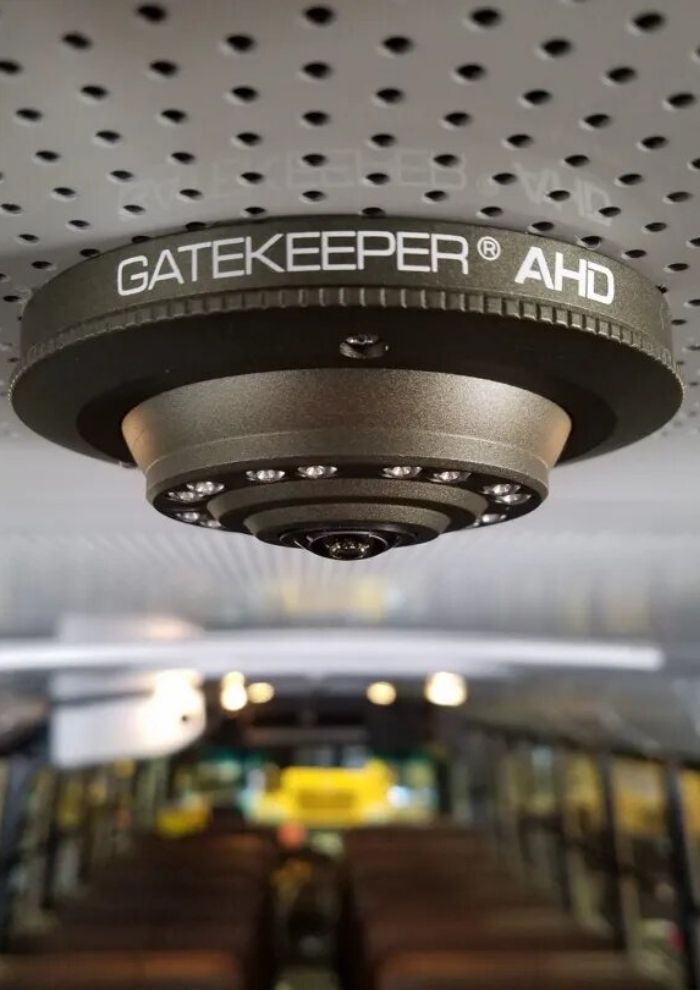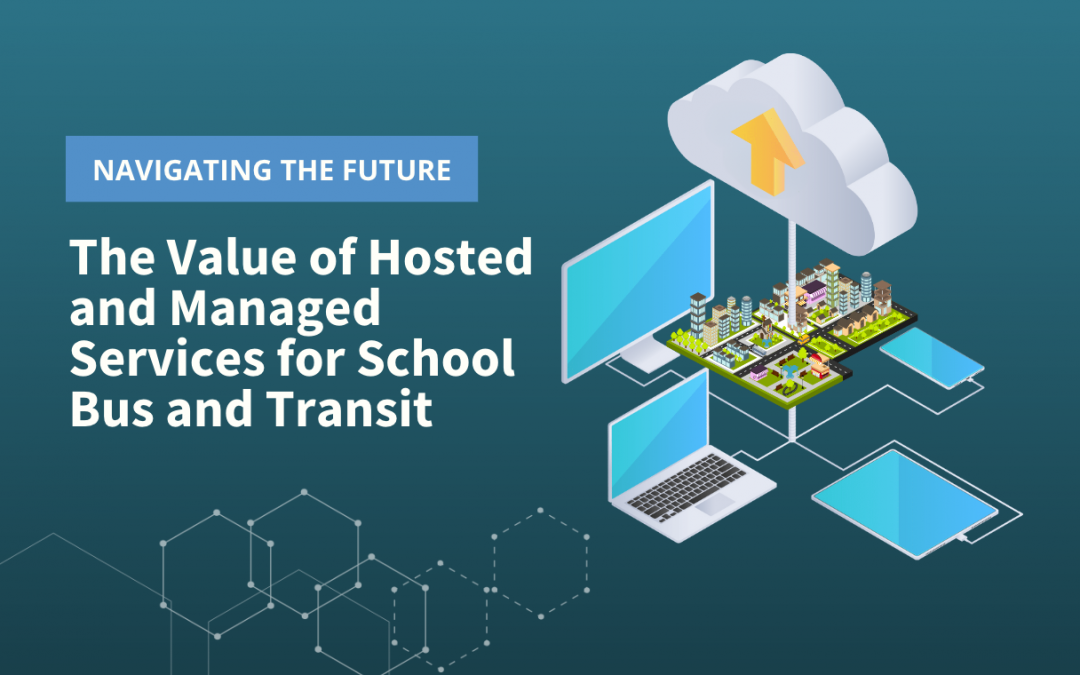Navigating the Future: The Value of Hosted and Managed Services for School Bus and Transit
Technology is evolving at an ever-rapid pace, and in the last several years it’s been reshaping school bus and transit systems.
Camera systems have been used in buses since the 1990s, but now they are able to do so much more than record video. Now they are part of a smart city ecosystem, making transportation safer and more efficient.
One of the key reasons for this transformation is the emergence of hosted and managed services.
Hosted services refer to applications or software that are made available to users over the Internet.
Managed services essentially are tasks that are handled by a third party. An example of a managed service is a company outsourcing their technological needs so they can instead focus on their core tasks.
Hosted and managed services play a large role in streamlining operations in both school bus and transit systems due to their connectivity, flexibility and scalability.
The Value of Managed and Hosted Services
At first glance, managing camera systems in-house might seem like the most practical option for school bus and transit operations.
However, it can become an overwhelming task given the complexity and quick-changing nature of today’s technology.
Using hosting and managed services allows transportation organizations to offload the burden of system maintenance, updates, and troubleshooting, freeing up valuable resources to focus on their core operational needs.
There is also the potential for significant cost savings. These services can eliminate the need for a large in-house IT department, reducing overhead expenses dramatically.
With a fixed monthly fee, managed services allow for better budget predictability.
Instead of sporadic, high-cost repairs, organizations can benefit from regular maintenance included in their service contract, preventing issues before they cause costly downtime.
Also, hosted services offer scalability that might be difficult or extremely costly to achieve otherwise.
As the needs of the school bus or transit operation grow, the hosted services can easily be scaled up to meet the increased demand.
This flexibility allows organizations to pay for only what they use, rather than investing in high-capacity in-house systems that may often go underutilized.
Managed services also contribute to reducing operational complications and bureaucracy by taking on the responsibility of managing complex IT systems
This allows the staff of school bus and transit operations to focus on their operations, rather than dealing with technological issues.
Using experts for a managed service also contributes to a less stressful work environment, as they handle everything from regular maintenance to troubleshooting and upgrades, which ensures that the technology supporting the operation is always running smoothly.
Using managed and hosted services can bring a wide range of benefits to school bus and transit systems, including cost savings, scalability, access to the latest technology, and optimized efficiency, all of which can help create safer, more reliable transportation.
Managed Services in Action
For school bus and transit systems, managed services can play a crucial role in boosting safety, efficiency, and control. Here are some of the most common types of managed services for school bus and transit camera systems:
- Remote Monitoring: Remote monitoring is when the camera system is continuously monitored for any issues. Cameras, recording devices, and network infrastructure are monitored to ensure optimal performance, and in the event that there is an issue, an alert is sent so that it can be resolved quickly.
- Data Management and Storage: Managing and storing large volumes of video data can be challenging for transportation providers. Managed services offer solutions for efficient data management and storage, including cloud-based storage options. This ensures that video footage is securely stored and easily accessible when needed for incident investigation or legal purposes.
- Proactive Troubleshooting and Support: Managed services provide proactive troubleshooting and technical support to address any issues that may arise with the camera system. This includes remote diagnostics, problem resolution, and guidance on system configuration. Proactive support helps minimize downtime and ensures the system operates optimally.
Gatekeeper’s Health Check is a managed service that can provide all three of these services.
It works around the clock, constantly monitoring systems for potential issues. This could include anything from a malfunction in the on-board DVR, to a camera that’s had its recording angle tampered with.
By catching these issues quickly, Health Check can help minimize downtime and reduce the impact on operations.
By using a managed service, school bus and transit operators can focus their operations and have peace of mind knowing that their systems are being proactively monitored at all times.
The Power of Hosted Services in Bus Operations
While managed services can be invaluable in helping to support the operational needs of school bus and transit systems, hosted services provide their own array of benefits, especially in connectivity and data management.
Hosted services offer comprehensive solutions that allow school bus and transit operations to gather, store, and process data remotely.
These services have become increasingly popular due to their wide array of benefits that help streamline operations and improve efficiency.
These cloud-based services essentially function as virtual data centers.
They collect large volumes of data from various sources, such as GPS systems, onboard cameras, route times, and more, and then store this data on secure, remote servers.
This data can then be processed and analyzed to optimize operations and improve service and safety.
Another one of the key benefits of these services is their scalability.
As bus operations grow, so does the volume of data they generate. Technology is also only going to get more sophisticated, and the data that these systems collect will only get more comprehensive.
Cloud-based services allow for seamless scaling, as additional storage space or processing power can be added as needed without having to invest in costly onsite hardware or software upgrades.
In addition, cloud-based services provide enhanced accessibility and flexibility.
Because the data is stored remotely, it can be accessed from any device with an internet connection, regardless of location.
An example of a hosted, cloud-based service that offers these advantages is G4 Vision.
G4 Vision is a cloud-based video and data storage and management platform. It securely stores video footage, making it readily accessible for incident review and investigations. It also offers advanced analytics and reporting capabilities, allowing transportation providers to gain valuable insights from their data.
The platform can generate customizable reports on bus stop duration, passenger counts, and route efficiency. These insights help operators to make informed decisions, optimize routes, and improve overall operational effectiveness.
Stop-Arm Camera Systems: Safeguarding Students and Enhancing School Bus Safety
The rise and advancement of technology has played a crucial role in making transportation safer, particularly for school buses.
One of the most important advancements in safety has been the adoption of stop-arm camera systems.
Boarding and exiting the school bus is the most dangerous part of a child’s commute, and these systems significantly enhance the safety of students as they get on and off the bus.
Stop-arm camera systems activate when the bus’s stop-arm is deployed, capturing video and images of vehicles that illegally pass the stopped bus.
These camera systems work by deterring stop-arm violations by holding violators accountable and increasing awareness.
Gatekeeper’s School Bus Student Protector is a hosted solution that captures high-quality evidence of stop-arm violations, and also offers seamless evidence collection and citation creation.
Lane Enforcement Systems: Boosting Transit Safety and Efficiency
As public transit systems work to keep pace with demand, maintaining efficiency and ensuring safety is increasingly critical.
Bus and transit lane enforcement systems help address these challenges.
These systems primarily focus on enforcing the proper use of dedicated transit lanes, which are specially designated routes that bypass heavy traffic and maintain timely routes.
They work in a way similar to stop-arm systems in that they capture bus and transit lane violators and hold them accountable.
They identify and record vehicles that illegally use these lanes, and then that footage is reviewed and, if necessary, a citation is issued.
These systems help ensure that dedicated bus and transit lanes remain open and unobstructed.
For transit operators, lane enforcement systems can significantly enhance their operational efficiency by keeping transit schedules on track, even during peak traffic times.
These systems also help to enhance safety by reducing the risk of collisions between buses and transit lane violators.
Gatekeeper’s Automated Lane Enforcement (ALE™) system is a hosted service designed for maximum accuracy and reliability. It automatically detects and captures every detail of a lane infraction, including license plate, date, time, location, and bus/train number. The comprehensive evidence is easy to extract to create citations.
It’s a versatile solution that can be adapted to various city infrastructures and transit systems that helps improve safety and efficiency.
Streamlining Operations with Integrated Solutions
There are many factors that go into managing school bus operations, from scheduling, dispatching, and payroll functions, to ensuring timely routes and monitoring passenger safety.
The logistics of school bus fleet management can be extremely complex, and the amount of data generated by these operations can be overwhelming.
Clarity™ is a hosted solution that provides a comprehensive set of tools and features that optimize the logistics of school bus operations.
Transportation managers can create and maintain annual schedules, manage daily schedule changes, and monitor daily dispatch with real-time status alerts.
This data can be seamlessly exported to payroll systems for easy and accurate time and attendance records.
The platform also utilizes an AI-powered that precisely records the number of students entering and leaving the bus. This information, coupled with the system’s ability to track on-time performance at stops helps the create the most efficient routes.
The platform also incorporates an advanced AI-powered Passenger Counter Sensor, which accurately tracks the number of students entering and leaving the bus.
This valuable data, combined with the system’s capability to monitor on-time performance at stops, enables transportation authorities to optimize their routes and provide a more efficient and effective service to students and the community.
One of the core benefits of this hosted solution is also its ability to combine multiple functions into a single platform.
By eliminating the need for spreadsheets, logs, and whiteboards, it saves time and reduces errors in managing daily operations.
The real-time data and analytics-driven solutions provided enable school districts to make informed decisions and improve safety, reliability, and efficiency.
Conclusion
Managed and hosted services play a pivotal role in optimizing and enhancing the operations of school bus and transit systems.
By using these services, transportation authorities can benefit from cost-effectiveness, streamlined processes, and enhanced safety.
Managed services offer continuous monitoring of camera systems, ensuring their proper functioning and timely troubleshooting.
This proactive approach minimizes disruptions, increases uptime, and improves system reliability. By outsourcing tech support, transportation authorities can focus on their core operational tasks.
Hosted services bring the power of cloud-based platforms to bus operations. These platforms enable remote access to critical data, real-time monitoring, and analytics, allowing transportation authorities to make data-driven decisions, optimize routes, and enhance operational efficiency.
This is the future of transportation, and s technology continues to advance these solutions will only become more powerful, driving the future of transportation towards greater optimization and safety.





